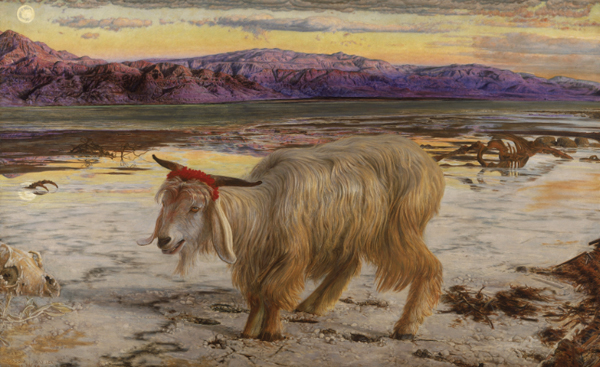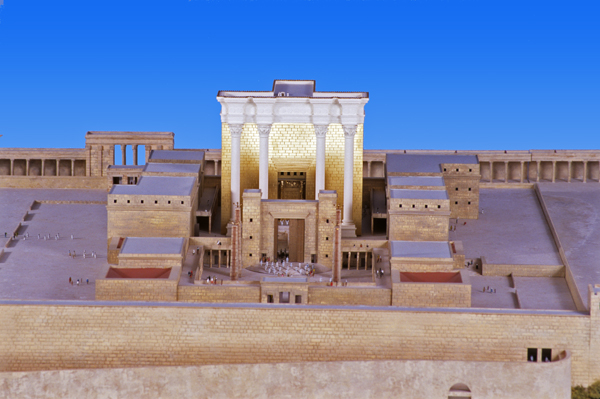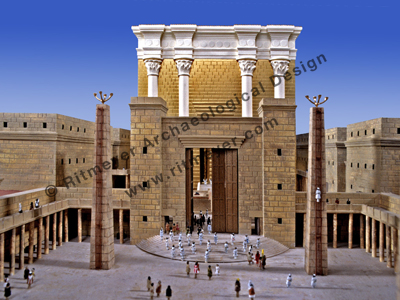I am often approached by people that are under the impression that the Eastern Gate of the Temple Mount had to be directly opposite the entrance leading into the Holy Temple. According to Middot 1.3, there was only one gate in the Eastern Wall of the Temple Mount: “the Eastern Gate on which was portrayed the Palace of Shushan”.
The Eastern Gate is an important gate of the Temple Mount, as on Yom Kippur the scapegoat that was chosen by the High Priest in front of the Temple, would have been led through the Court of the Women, down a stairway to and through the Shushan Gate and into the Kedron Valley. From there it was led over the Mount of Olives into the Wilderness of Judea.

Another biblical scene takes us to the top of the Mount of Olives, where a priest would sacrifice a Red Heifer. Numbers 19 stipulated that in order for the people to be purified, a Red Heifer should be sacrificed, its ashes collected and put in a container with water. This was used to sprinkle those in need of purification. The Mishnah said that the priest that was consecrated to burn the Red Heifer would leave the Temple Mount with the Heifer and go through the eastern gate to the Mount of Olives. The problem of the identification of the eastern gate lies in two passages, in Mishnah Parah 3.9 and 4.2. The first states that the priest that offered the Red Heifer on the Mount of Olives, sprinkled its blood seven times toward the Holy of Holies. According to the second passage, “if the blood was sprinkled not in the direction of the entrance [of the Holy of Holies] it is invalid.” There must therefore have been a direct line of vision between the Mount of Olives and the entrance to the Temple. From the place of this activity, he could look straight through the Nicanor Gate and see the entrance to the Temple.

The idea that the Shushan Gate had to be directly opposite the entrance to the Temple comes from a misunderstanding of the passage in Middot 2.4: “All the walls there were high, save only the eastern wall, because the [High] priest that burns the [Red] heifer and stands on top of the Mount of Olives should be able to look directly into the entrance of the Sanctuary when the blood is sprinkled.” Does that mean that the Eastern Gate of the Temple Mount should be on the same line of vision, drawn between the Temple and the top of the Mount of Olives?
Looking from the top of the Mount of Olives through the Golden Gate one could never see the Temple, wherever one places it on the Temple Mount, as that gate is located far too low down. One cannot expect to look through a lower gate and see something that is higher than that gate. Only the drawing of a section would make that clear. In order to solve architectural problems, one needs to think in three dimensions.
The level of the top of the Mount of Olives (810 m. above sea level) is 75 m. (246 feet) higher than the Temple platform (735 m.). The sill of the Golden Gate is located some 21 m. (70 feet) lower than the Temple platform. How then could one look from the top of the Mount of Olives through the Golden Gate, or any other gate in the Eastern Wall of the Temple Mount, and hope to see the entrance to the Temple? It is totally impossible!

We must conclude that the passage in Middot 2.4 needs to be read differently or that the writer didn’t remember the actual line of vision. Which walls are referred to by “All the walls …”? Those of the Temple Mount or those of the Temple Courts? The previous passage (Middot 2.3) describes structures “inside the Temple Mount” and it ends with a reference to the Nicanor Gate. This was an extraordinarily beautiful gate with bronze doors made in Alexandria, that stood between the Temple Court and the Court of the Women, right in front of the Herodian Temple .

There is a direct line of vision from the top of the Mount of Olives to the entrance to the Temple through the Nicanor Gate, while the walls of the Court of the Women were kept low (see illustration above). If one stands today to the east of the Dome of the Rock one can see the Mount of Olives clearly. The Nicanor Gate therefore is the only gate that the writer of Middot could have had in mind. The High Priest that offered the Red Heifer on the Mount of Olives would have had to look through this gate in order to see the entrance to the Temple. I believe therefore that the gate mentioned in Middot 2.4 is the Nicanor Gate and not the Shushan Gate.

Michael,
Jesus would not have been able to ride up to the Temple doors, as the Temple Court was off limits to all non-Levites. It is more reasonable to suggest that he rode to one of the city gates and then continued on foot as the city would have been very crowded during the Passover holidays.
the mercy gate is not sha’ar shushan the sha’ar shushan was discoverd by an Arab and he coverd it up with dirt. the remains of this gate is directly across the dome of the rock which many great sages throughout the ages said that that the dome of the rock is the foundation stone not the dome of the spirits!!!
Anonymous, I agree that the Foundation Stone is inside the Dome of the Rock and not under the so-called Dome of the Spirits. About the Shushan Gate, no such gate was ever found in the Eastern Wall opposite the Dome of the Rock. This alleged covering up by an Arab sounds like a fairy tale. Inside the Golden Gate are gate posts that date back to First Temple times. You may not agree that this belonged to the Shushan Gate, but as there was only one gate in the Eastern Wall, there can’t be another one.
You did a wonderful job here. I commend you in the name of the Lord. But may I make one comment? While you are absolutely correct that the place of the Miphkad altar on the top of Mt Olives where the Red Heifer sacrifice was made has a line of sight above the eastern gate, not through it, the place that the Red Heifer sacrifice was fulfilled is actually just below the Miphkad altar. Many Protestant reformers had information that seems to have been forgotten by the more recent scholars or how could Charles Spurgeon make this comment… “And being in an agony he prayed more earnestly: and his sweat was as it were great drops of blood falling down to the ground” (Luke 22:44). “We believe, then, that Christ did really sweat blood…If you will notice, he not only sweats blood, but it was in great drops; the blood coagulated, and formed large masses. I cannot better express what is meant, than by the word ‘gouts’ – big, heavy drops…when it is said ‘falling to the ground’ – it shows their copiousness, so that they not only stood upon the surface and were sucked up by his garments TILL HE BECAME LIKE THE RED HEIFER WHICH WAS SLAUGHTERED ON THAT VERY SPOT, but the drops fell to the ground.” {The Metropolitan Tabernacle Pulpit, number 493, 1879.}
Now please think on this brother. If Jesus fulfilled the Red Heifer sacrifice in Gethsemane, which was just below the Miphkad altar on the terrace at the foot of the hill, then would THIS not be the spot that could be seen through the Golden Eastern Gate? When the clean man flung the blood of the Red Heifer in the direction of the Temple it would fall on Gethsemane where the Red Heifer sacrifice was fulfilled in 31 AD.
Also when the day of Atonement came and the high priest would enter the Most Holy Place where the shekinah glory rested, and because of the gold covered walls the glorious light would fill the Holy place and be amplified like a laser amplifier chamber and shoot out of the Eastern Gate and spotlight both the Miphkad altar and the Garden of Gethsemane. I am positive this will be found perfectly sound logic.
I hate to sound thickheaded, but this double gate in the east wall is referred to as both the Golden Gate and the Shushan. Are they different names for the same gate, or was one portal named the Golden Gate and the other named the Shushan?
Robert,
This gate was given the name of the Golden Gate in th Crusader period. The earlier First Century name, as recorded in Mishnah Middot 1.3, was the “Eastern Gate on which was portrayed the Palace of Shushan”, hence the Shushan Gate.
Was it really necessary to look through any gate inasmuch as the Temple being 23′ higher than the dome would have been clearly visible from the Mount of Olives? I mean the High Priest had to sprinkle seven times the red heifer’s blood towards the sanctuary. Was he not able to see above the walls from the Miphkad altar?
Also what about the miphkad gate also known as the inspection gate? Wasn’t it also referred to as the Golgotha gate? Wasn’t this gate also facing the Mount of Olives not far from the Eastern Gate?
Shoshana,
The high priest standing on top of the Mount of Olives could never have seen the Temple through the Golden Gate, then known as the Shushan Gate. But he could have looked through the Nicanor Gate that stood in front of the Temple.
About your other question, I have never heard the Miphkad Gate being equated with a Golgotha Gate, a gate I have never heard of. The Miphkad Gate, also known as the Inspection or Muster gate, was a gate in the city wall below the Temple Mount.
Professor Ritmeyer
Thank you for your insightful work. Can you comment on the findings suggestive of being the Parah Adumah site at the Dominus Flavus Church courtyard, its vertical height on the Mount of Olives and (by my observation) its line of site relationship to the aforementioned gates
Rabbi M,
The courtyard at the Dominus Flavus Church is too low in order to see the entrance to the Temple.The Eastern Wall would have onscured the view.
Thank you for your answer Leen, so when you say “The Miphkad Gate, also known as the Inspection or Muster gate, was a gate in the city wall below the Temple Mount.” are you referring to a gate below any of the present gates? I’ve read about excavations of an existing gate under the Eastern Gate.
Could it have been seen from what is now the back garden area of the All Saint Church? When I was in Jerusalem recently and our group stood outside (I did not go into the church) the Ruach pointed to this area.
Shoshana, No, that is far too low. Only from the top of the Mount of Olives could the entrance to the Temple be seen.
Shoshana,
It was once thought that there might have been an earlier gate below the Golden Gate, but that has been disproved. The Miphkad Gate was a gate in the city wall and not in the Temple Mount.
Dear Leen,
first of all I want to thank you for the extraordinary work you provide and the calm and unagitated reasoning and explaining!
I am graphic designer and occupy myself privately in cartography. Currently I’m working on a detailed map of Jerusalem. My aim is to at some point gather all different phases of the architecture and urban layouts in one layered map, providing the possibility to superimpose all phases from Jebusites’ times to today.
Reason tells me (I might be mistaken) that the angles and orientation of the Temple structures of the different periods are essential for the drawing of the surrounding chambers (e.g. The Hall of Hewn Stones) of that specific periods.
Thus, the architectural angle and orientation of the First Temple and the Second Temple are essential.
Reading your post and assuming that the Ark of the Covenant, the entrance to the Holy Temple, the Nicanor Gate and the exact spot of the sacrifice of the Red Heifer are in one visual axis (regarding cartographical north) one question pops up:
If the exact spot for the “sacrifice” of the Red Heifer is known (I tend to think it is: https://www.youtube.com/watch?v=ZpJcRZxHWQI) and a line from that point to the center of the placement of the Ark which is known, too, would be drawn, would that be sufficient scientific evidence or proof of the exact angles and orientation the First and/or Second Temple where built?
Did the First and Second Temple even have the same orientation?
Studying your posts and drawings or aligning them with my GIS, don’t give me an exact answer.
Was the angle of religious significance or only of practical significance being able to see the entrance to the Temple?
I know, I ask a lot, but you made me curious… 😉
What are you thoughts about that?
Thanks a lot,
Ronen
Ronen,
Thank you for your interest in the Temple layout and my work. The orientation of the Eastern Wall of the Temple Mount is at right angles with the central axis of the temple. This axis is a line from the centre of the Holy of Holies, where the Ark of the Covenant stood, to the top of the Mount of Olives. http://store.ritmeyer.com/node/195:
This is the only alignment that would allow the priest that sacrificed the Red Heifer to look straight toward the entrance of the Temple (Middot 2.4). See my book The Quest – Revealing the temple Mount in Jerusalem, p.267.
The Holy of Holies was placed above The Rock that is visible inside the Dome of the Rock. The west and north side of this rocky outcrop have been straightened with vertical cuts to allow the west and north walls of the Temple to be built at the bottom of these scarps. The total height by which The Rock stood above its surroundings was 2.75 m. Even if the First Temple was completely destroyed, this Rock would still be there, a prominent feature standing high at the top of the mountain. It would have been difficult to ignore this when the Second Temple was built. As the size of the Holy of Holies of the Second Temple had the same dimensions as the first, it would have been virtually impossible to choose a different alignment.
Hope this helps.
Leen
I am not familiar with the Iron Age/First Temple period masonry at the Golden Gate. The only Iron Age wall I’m familiar with is the one on the Ophel. Can you point me to more information on the Iron Age wall at the Golden Gate. Thanks.
We have published this type of masonry in the Eastern Wall of the Temple Mount in several books, such as The Quest, pp. 174-178, and Jerusalem the Temple Mount, pp. 80-85, see: https://www.ritmeyer.com/product-category/books/